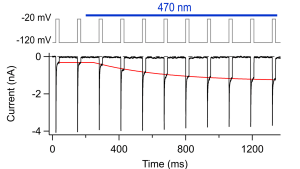Sodium channel with selenocysteine senses phototoxicity
Pulse protocol (top) and current recordings of roNaV2 channels in HEK293 cells (bottom). The blue bar marks illumination of the cell with blue light via a 63x objective. The red curve is a mono-exponential fit to describe the time course of inactivation loss upon illumination.
Illustration: FSU BiophysikThe detection of cellular reactive species (RS), either endogenously produced or generated by illuminating cells during life-cell fluorescence imaging, is a demanding task because of the labile nature of RS. To measure the influence of RS and the impact of blue light close to the plasma membrane we introduce here a voltage-gated Na+ channel harboring a selenocysteine in its inactivation motif: roNaV2. Current measurements of roNaV2 yield ratiometric signals that report on local occurrences of RS without the need for confounding cell illumination. In addition, roNaV2 is reversible and its sensitivity towards light can be switched on and off by means of the electrical membrane voltage.
